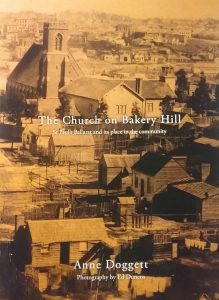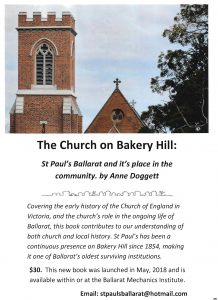The Church on Bakery Hill
With a history of lofty ideas, eccentric clergymen and moments of devastation, St Paul’s Church at Bakery Hill has just been waiting for someone to dive into the archives.
Historian Dr Anne Doggett has just released The Church on Bakery Hill, a chronicle of the church’s more than 150 year history.
The Church on Bakery Hill
Some excerpts from the book…
Introduction
A church destroyed by underground mining. A plot to rid themselves of a turbulent priest. And a clergyman forced to line his cottage with mattresses in an effort to protect his family from gunfire. There was no lack of drama when the people of Ballarat East set out to establish a church of their own. Stories of determination, tragedy, bravery and intrigue mingle with the day to day life of the church as St Paul’s gradually became a familiar presence on Bakery Hill. If we are to understand the society we live in today, it is important that we recognise the church’s role in our history. This book traces the way one particular church has made a difference in the lives of the people, and in the development of a community, over the course of a fascinating 162 years.
Early days
One dark winter’s evening in 1856 a newcomer to Ballarat East was carefully making her way to church. With the aid of a large, old-fashioned stable lantern, she picked her way along a narrow path around the sides of a cutting. The church was situated near a corner at the intersection of two deep cuttings—one constructed in a clumsy attempt to decrease the steep gradient and ease the burden for drays as they pulled their heavy loads from Ballarat to Melbourne, and the other one crossing it at right angles. Small wooden dwellings were situated on each side of the chasm, all looking perilously close to the edge.
Bakery Hill
In the mid 1850s St Paul’s shared the neighbourhood with a bootmaker, a watchmaker, a gold broker, auctioneers, timber merchants, wine and spirit merchants, a theatre, a hotel, stables, newspaper offices, dining rooms, schools and churches. The local Temperance Hall stood beside the church, and two doors away undertaker Charles Morris carried out his busy trade. A number of doctors lived and worked in the area, including Dr Wills, whose son William acted as his assistant surgeon. Just a few years later, while acting as second-in-charge to Robert O’Hara Burke, William lost his life on the famous expedition through the interior of Australia, on the tragic return journey from the Gulf of Carpentaria.
Education
A school was established in the church building in the first part of 1855, and by April 1858 it was the most flourishing school in Ballarat, and the largest in the colony outside Melbourne and Geelong. There were 220 children on the roll, and while low attendances were typical of the schools on the goldfields, St Paul’s had a higher than average attendance for the district. Parents of most of the school children were miners, or tradesmen, and there were 29 pupils on the free list, representing those families unable to afford the school fees. Denominational school inspector James Bonwick referred to St Paul’s as ‘the best school in my district. Excellent teaching, good working order, thorough moral training’.
Disaster
On the afternoon of Friday, 1 April, 1864, a violent storm struck Ballarat, following days of sultry weather. Shortly after midnight the storm increased in intensity, with great bursts of lightning and thunder, accompanied by heavy rain. The storm continued throughout the night, and at daybreak on Saturday those who had managed to sleep were roused by flashes of lightning and crashing of thunder. The storm soon abated, but the severity of its impact was immediately apparent. The sexton of St Paul’s, while surveying the storm damage, noticed some fissures in the ground on the south-eastern side of the church, and worse, some cracks in the church wall. When the trustees were called to inspect the damage it was found to be even more serious than it had first appeared. Both the north and south walls were cracking for around two thirds of their length, and the horrified trustees were forced to admit that their church was no longer safe to enter.
Welfare
There has never been a time in the history of St Paul’s when the needs of the church have prevented people from contributing to the care of the underprivileged. The Rev’d Robert Cummins, during his long incumbency (1860-1887), was committed to supporting the needy by giving financially, establishing support organisations, and encouraging an awareness of the needs of others. Most of this activity has received little acknowledgement, but records in St Paul’s archives document a long unbroken history of visiting people in hospital and in prison, of raising money for those in need, and of allotting a percentage of income to charities, even in times of financial hardship. In a pre-welfare society people relied heavily on the church and many continue to do so today.
Women
Women have worked hard for their church, and have usually received public recognition for their efforts. Even in the early years women took on significant roles. When the new pipe organ was installed in 1865 the organist was a capable young female musician who had studied in England, and there have been others since. Without the fundraising efforts of women, St Paul’s would have found it hard to survive, and as the years progressed they have taken increasingly varied roles, as school teachers, Sunday School teachers, leaders of social groups, readers, Eucharist assistants, fund-raisers, members of council, church wardens, church cleaners, flower arrangers, office workers, vergers, lay assistants and more. In August 2016 a parish celebratory Eucharist and dinner honoured the contribution of Corrie Eveleigh, sacristan of St Paul’s for over 30 years.
Music
Religion and music have always shared a close relationship. Such is the importance of music in Christian worship that architects design their church buildings around the musical needs of the congregation. A gallery was built in the current St Paul’s building for organ and choir, and since then, whenever the interior of the building has been modified, an appropriate space for music has always been one of the primary considerations. In May 1865 the new pipe organ arrived from England, the culmination of planning and hard work by the whole church community. Built by JW Walker, London, 1864, it has been in continuous use from 1865 until the present, regularly maintained and updated thanks to the dedication of generations of church-goers. The long succession of musicians who have taken their place at the console include some of Australia’s finest organists. Although other instruments have been used from time to time, the organ has never been supplanted as the primary source of music, and is part of the long musical tradition of the Anglican Church, for which it is ideally suited.
Worship
St Paul’s has been standing on Bakery Hill from the early gold-rush period to the twenty-first century. And for all those who are part of the church, one thing stands at the heart of their involvement. Worship is central to church life. It sets the church apart from other institutions that speak up for human rights, offer help to the needy, perform great music, study readings from ancient literature, or provide social interaction. The church on Bakery Hill has been a living part of the Ballarat community for longer than almost any other local institution, defined and sustained by the continuous background of worship that has resonated through both church and community for over 160 years.
The Ballarat Courier’s article covering the release of the book can be found here.
The Church on Bakery Hill is available from the Parish Office. Contact us

